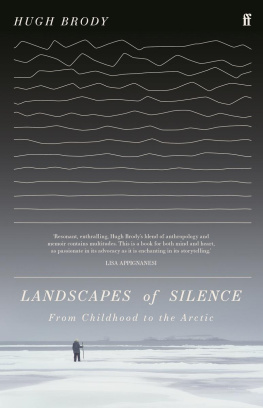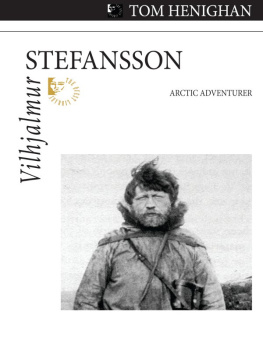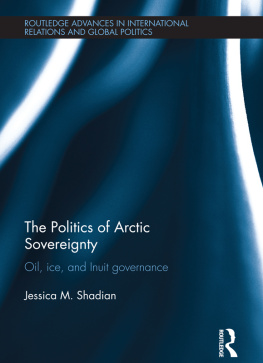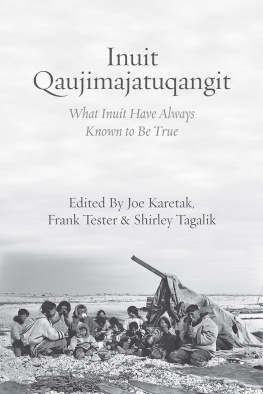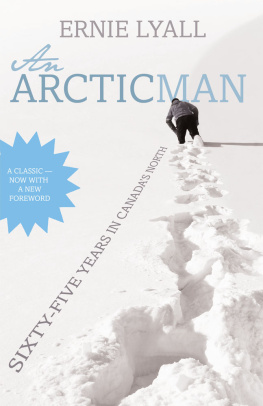An Intimate Wilderness

Copyright 2016 by Norman Hallendy
All rights reserved. No part of this book may be reproduced, stored in a retrieval system or transmitted, in any form or by any means, without the prior written consent of the publisher or a licence from The Canadian Copyright Licensing Agency (Access Copyright). For a copyright licence, visit www.accesscopyright.ca or call toll free to 1-800-893-5777.
Greystone Books Ltd.
www.greystonebooks.com
Cataloguing data available from Library and Archives Canada
ISBN 978-1-77164-230-9 (cloth)
ISBN 978-1-77164-231-6 (epub)
Jacket design by Nayeli Jimenez and Robert Hoselton
Interior design by Robert Hoselton
All photographs by Norman Hallendy
We gratefully acknowledge the support of the Canada Council for the Arts, the British Columbia Arts Council, the Province of British Columbia through the Book Publishing Tax Credit, and the Government of Canada through the Canada Book Fund for our publishing activities.

Inuksuliriji, I respect you highly, my friend Norman. You are a wise man, knowledgeable, and a man of honour. I am proud to be your friend! You are a friend to all Inuit. We thank you.
Piita Irniq Commissioner of Nunavut 20002005.

Osuitok and I at Kinngait (Cape Dorset), 1998.
A PROMISE KEPT
to
Issuhungituk Qiatsuq Pootoogook, Oshutsiak Pudlat, Pudlo Pudlat, Quvianaqtuliak (Kov) Parr, Ikkuma Parr, Pauta Saila, Pitaloosie Saila, Eegyvudluk Pootoogook, Kananginak Pootoogook, Pudlat Pootoogook, Paulassie Pootoogook, Joanassie Salamonie, Kiawak Ashoona, Pitseolak Ashoona, Qaqqaq Ashoona, Majuriaq Ashoona, Kenojuak Ashevak, Pingwartuk, Ottochie Ottochie, Itidlouie Itidlouie, Kingmeata Itidlouie, Lukta Qiatsuq, Mannumi Davidee, Munamee Sarko, Kingwatsiuk, Simeonie Quppapik, and Osuitok Ipeelie
Im telling you these things so that they are written. Write carefully, you are carrying the remains of our thoughts.
isumagijaujut kinguvaariinnuuqattaqtut Osuitok, 1998
CONTENTS
The early years and a time of discovery.
Growing up in a rough-and-tumble neighborhood in Toronto and attending the Annual Prospectors Convention, a raucous gathering of prospectors and miners that inspired the authors northern travels.
The Arctic, its vastness, beauty and a love of the land.
Arriving in Cape Dorset in 1958, when the Inuit are moving from traditional camps to settlements created by the Federal Government. Kananginak Pootoogook, son of powerful camp boss, talks about how living in a settlement affected him.
Pingwartuk who was the first to take the Inquisitive One out on the land offers the formula for staying alive. The author travels at sea with Lukta Qiatsuq, who gets them out of a very serious situation by using the aluminum foil from a package of cigarettes.
Simeonie Quppapik, who was photographed in 1923 by the legendary American filmmaker Robert Flaherty, talks about his lineage and offers sharp insights on the importance of words.
Kananginak Pootoogook relates his life story. He was born in a hut lit by a seal oil lamp in a camp reached by dogsled in winter and kayak in summer, at a time when it was believed that shamans could fly to the moon. Later in life, he watched men landing on the moon from the comfort of his home in Cape Dorset, which was heated by oil from Venezuela.
The author learns the rules of proper behaviour and the proper way to ask questions of the elders.
How to separate myth and legend from reality.
The author gives a panoramic view of the remarkable locations all around him: the Foxe Channel, Southampton Island, Igloolik, the ancient camps of Nurrata and Nuvudjuak, Cape Dorset, and the Great Plain of the Koukdjuak.
The author and Itulu Itidlouie set off for the small island of Sarko, and barely return alive.
What its like dining out on walrus, whale skin, eider duck eggs, ptarmigan, and caribou, while avoiding, fermented meat or fish, the eyes of animals, and fully formed chicks still in their eggs.
The Inuit view of memory, maps and map making.
An elder talks about traditional techniques for hunting whales.
Understanding the complex meanings of inuksuit, the human made stone figures and markers placed on the Arctic landscape.
A meditation on the cycle of life growing in the shadow of a single inuksuk.
An illusion of reality.
Osutsiak Pudlat talks about how inuksuit were used as hunters aids.
The author travels with Ohito Ashoona and his son to Inuksugalait where at least 100 inuksuit stand within an area of three hectares. In this place, one is overcome with a sense of spirituality and awe.
Travelling by helicopter, Paulassie Pootoogook leads the author to an ancient site rivaling Inuksugalait. With careful observation of the entire site and its relation to the caribou migration, the author unravels its mystery.
Memorable encounters with polar bears and ravens.
One Inuit legend about how the Northern Lights came to be.
The strange phenomenon of lightning in the ice.
The author observes a very strange occurrence and learns from elders about the power of the moon.
Ethereal sightings when travelling on the land.
As the sun sets, a fiery column of light forms and reaches skyward. Then, a full moon appears to rise out of the sea, like a great paper lantern floating heavenward.
The author experiences kayak sickness, a disorientation so extreme that he did not know up from down or where he was upon the sea. An elder talks about dangerous act of gathering clams below the ice in springtime.
Arctic phenomena such as ice blinks, ground drift, sundogs, diamond dust, and a time when the air appears to be filled with glittering ice crystals.
Majuriaq Ashoona talks about the womans role in Inuit traditional society.
Ikkuma Parr and a small group of women share their stories of camp life, arranged marriages, the status of women, traditional remedies, and the worst things that could happen to a woman in camp.
Osuitok Ipeelie talks about the difference between what he believed to be true and what he knew to be true, and offers a story about a cannibal witch.
Springtime in the southwest Baffin region, and the land awakens from a deep sleep.
Osuitok Ipeelie discusses different types of dreams, some based on what one knows to be real, others that give a glimpse of the future.
Osuitok Ipeelie on the five states of mind beyond dreaming.
There was a time when Inuit believed in the existence of helpful and evil tuurngait (spirits) who were called upon by shamans to perform all manner of tasks.
On the metaphysical landscape of the Eastern Arctic places where life was renewed, strict customs observed, and celebrations staged.
The difference between woking in the field and living on the land.
An elder from Kugluktuk (Coppermine) shares stories about charms: ones that attract good luck, allow the owner to perform superhuman feats, or offer a glimpse of the future.
The elder from Kugluktuk (Coppermine) continues his stories about a deadly snowman made by a shaman. Such an effigy could be used by the shaman to capture the spirit of the person destined to be either harmed or killed.


